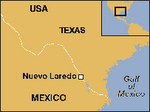The following story was first published in the spring of 2004 in La Prensa Newspaper of Austin, Texas. It warns what could happen if a new “guest worker” program is launched and the guests invited to the great U.S. dinner table are themselves eaten...
By FRANK LEVINE
While the Bush Administration and Mexican President Vincente Fox Quesada danced around a new proposed “guest worker program,” more than 2,000 former Mexican “braceros” briefly invaded Fox’s “San Cristobal” family ranch in the Mexican state of Guanajuato, Feb.16 igniting a political firestorm that engulfed presidential security forces, former and current immigration policies, and the alleged “disappearance” millions of dollars reportedly earmarked for an earlier generation of so-called “guest” workers.
“No one knows how much money is missing,” said Carlos Marentes, director of the Centro de los Trabajadores Agricolas Fronterizos in El Paso. “All we get from both governments and the banks is silence…But some experts estimate the amount monies ‘disappeared’ at $500 million in today’s dollars.”
Missing as well, he says, is the political will to resolve the issue and, for that matter, the will to explore reasonable alternatives to current immigration policies fraught with abuse, tragedy and injustice on both sides of the border.
Monday, an additional 4,000 former braceros – reportedly not directly associated with those who invaded the president’s home -- marched three miles from “El Angel,” on Mexico City’s Paseo de la Reforma, to the official presidential residence at Los Pinos, where 14 bracero representatives held what had been described as “frank and open” discussions with the president. Little was resolved, but additional talks are planned for next week, according to government sources.
Meanwhile, in the aftermath of the surprise takeover of the ranch, Mexican government agencies, intelligence services and the military, bickered over who would be held responsible for the embarrassing political and security snafu. Hearings and investigations were called for -- not to resolve the issues at hand, but to chastise the
demonstrators and their leaders for tramping on sacred presidential ground.
In a Monday press conference, Mexican Attorney General Rafael Macedo de la Concha said he ordered local prosecutors to file criminal complaints against those presumed responsible for invading the president’s family ranch; while at the same time Interior Ministry Secretary Santiago Creek Miranda stated the president has demanded that his office file both state and federal charges against the intruders – many of whom are men in their 70s and 80s.
By Tuesday evening, however, there were indications the government position was softening under political pressure, and that the Fox family was reluctant to file criminal trespassing complaints against the intruders, even though some unconfirmed reports indicated the mother of the president had fainted during the invasion and the sister of Fox spent three hours in discussions with the braceros.
These initial reports have been denied by the government.
And the bracero money?
Like they say in New York… “Forget about it…”
The so-called “Bracero,”or government sanctioned guest worker program, began in the aftermath of the devastating Mexican Revolution and the failure of the post-revolutionary Mexican government to address pressing social and economic demands of the country’s rural poor.
By the late 1930s, Mexico’s rural “campesino” population was battered by a worldwide economic depression, plummeting prices, and failing crops. Survival, in both political and social terms for the young Mexican government, demanded that millions of marginalized young workers find sustenance somewhere else.
That somewhere was in the United States, were relatively unskilled “arms” or “braceros” were desperately needed to temporarily fill the ranks of farm workers and laborers called off to war.
So on August 4, 1942, less than a year after the Japanese attack on Pearl Harbor, “a memorandum of understanding” was signed between both governments opening U.S. borders to an annual migration of tens of thousands of “braceros.” The program eventually processed nearly 4 million workers, continuing with slight modifications until its official ending on May 30, 1963. Some were allowed to continue working through the end of their contracts in 1964, but those remaining in the U.S. after their contracts ended were quickly rounded up and deported.
What began as an idea that would benefit both countries, soon degenerated into an uncomfortable reality. By the end of the program, after decades of reported abuses and injustices, Lee G. Williams, the former U.S. Department of Labor officer in charge of the program, described it as a form of "legalized slavery."
Four decades later, most of the braceros are no longer able to support themselves. But part of the program, according to the braceros and their supporters, required that U.S. employers send 10 percent of each worker’s earnings to a Mexican government bank to be used as a “social security” or retirement savings fund.
This clause of the agreement remains open to debate on how it was to be implemented. By “security,” most braceros believed that monies would be waiting for them when they returned to their homes in Mexico to purchase farm equipment…And indeed some did receive monies, as indicated by some bank records. But the vast majority of workers claim they received nothing.
The actual agreement calls for the creation of a “rural savings fund,” part of which, it appears, was to be used by the workers and their communities to purchase farm equipment from U.S. companies. No one knows what percentage of the monies was actually used for this purpose, and what percentage of the monies vanished into a banking and bureaucratic “black hole.”
The original “Letter of Agreement,” formalized by an exchange of notes between government representatives in Mexico City in 1942, and modified in 1943, read, in part:
“The respective agencies of the Government of the United States shall be responsible for the safekeeping of the sums contributed by the Mexican workers toward the formation of their Rural Savings Fund, until such sums are transferred to the Wells Fargo Bank and Union Trust Company of San Francisco for the account of the Bank of Mexico, S.A., which will transfer such amounts to the Mexican Agricultural Credit Bank. This last shall assume responsibility for the deposit, for the safekeeping and for the application, or in the absence of these, for the return of such amounts.
It was a good idea, somewhat reflective of the Roosevelt Administration’s progressive view on labor relations, and the perspective of the post-revolutionary government of President Miguel Avila Camacho, still cowering in the shadow of the folk hero-President Lazaro Cardenas del Rio. For Camacho, the interests of Mexico were best served by keeping the country out of direct participation in the war for as long as possible. He managed to do that until 1943, when finally, under increasing U.S. pressure, he allowed the formation of the 201st Mexican Air Force fighter squadron that did indeed see some action in the closing days of the Pacific War.
But for decades since the end of the program, former braceros have demanded their money. The U.S. government and its “subcontractor” employers claimed to have sent the money to the banks; while the Mexican government, on the other hand, claims it doesn’t know what happened to the money and, besides, it can’t afford to pay such massive claims now.
And the banking institutions that were entrusted with the millions upon millions of dollars allegedly claim they no longer have records, either showing transfers or receipts of the monies.
“We have receipts showing the 10 percent deductions through 1949,” Marentes says. “That’s seven years of proven deductions…So where is the money?”
According to Interior Ministry sources, there are about 80,000 individuals on file who may be eligible for payment, with an additional 800,000, including widows and survivors, waiting in the wings.
“The government simply can’t afford to pay out so much money,” an Interior Ministry spokesman said. “We must try to find alternatives.”
Among the alternatives suggested were the incorporation of former braceros and their families into the national Social Security Institute which, unlike the U.S. system, offers free or nearly free medical attention to working families, as well as other benefits.
But for the braceros and their families, the government offer may not be enough and pressure is building – after much debate -- in the Mexican Legislature to find a solution acceptable to all sides.
Marentes, meanwhile, says that a commission recently spent three years trying to figure out what happened, and to offer solutions to the problem.
“After years of investigation…talking with U.S. and Mexican bankers, government officials and others, the end result was that nothing could be done,” Marentes says. “No one could find records proving or disproving the claims.”
He admits that some monies eventually found their way back to Mexico, and in one case were used to purchase a few tractors for an “Ejido,” or collective farm. Ejidos were created in the aftermath of the Mexican Revolution from properties usually confiscated from wealthy landowners. By the 1930s, it was clear to the Mexican government that the Ejido program was in trouble as it could not effectively compete with more advanced agricultural societies, including the United States, as long as modern farm machinery was unavailable.
That may indeed be the reason why the Mexican negotiators at the time insisted on the “rural savings account” to help finance the modernization of Mexican agriculture. The U.S. negotiators, meanwhile, saw the plan as an expedient political and economic opportunity, forcing the Mexican government to buy only U.S. made equipment at retail prices.
One 75-year-old bracero, interviewed for this story, said:
“I guess the program did some good…It helped us and helped them. But the work was very, very, hard and it is a shame that so much money is missing….I could certainly use some of it now.”
Sunday, March 27, 2005
Former "braceros" left with open hands
Posted by
Frank Levine
at
02:25
0
comments
![]()
Labels: banks, braceros, corruption, labor abuse, labor law, mexican government, migrant workers
Subscribe to:
Posts (Atom)






